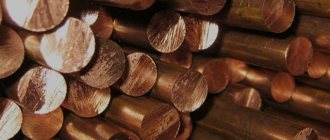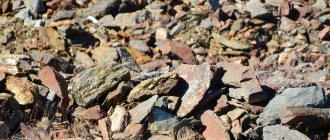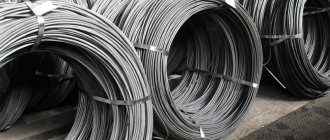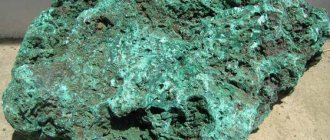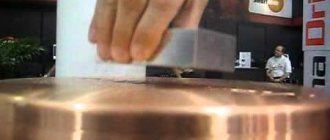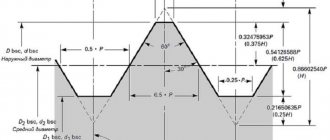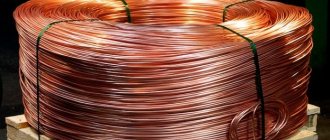When heat treating copper and its alloys, two features of the material are taken into account: increased thermal conductivity and interaction with gases when heated. It is these factors that cause rapid and uniform heating of the metal along the perimeter of the section. Annealing copper is heating the metal followed by cooling, allowing you to change the properties of the material. Heat treatment makes the metal softer and more ductile. Copper is used in various fields where ductility is important.
Annealing of copper
Advantages and disadvantages of processing
An undeniable property of copper is its high electrical conductivity. It is used in construction and the manufacture of electrical equipment. The mechanical parameters of the metal are quite low, so it is not often used as a pure structural material.
Benefits of annealing:
- the treatment removes harmful substances from the metal and removes bacteria;
- the workpiece becomes soft and elastic, withstands pressure over 200 atmospheres;
- the material becomes resistant to corrosion;
- increase in hardness - the part can be bent several times without fear of cracks;
- reduction of residual stress during incomplete annealing.
There are significantly fewer disadvantages, but they still exist:
- the material requires slow cooling;
- copper is an expensive material;
- If handled incorrectly, soft metal can be damaged.
Why roast copper and how to do it
Russian legislation provides for several federal laws, articles of the Criminal Code and the Code of Administrative Offenses, as well as government regulations that prohibit the lighting of fires, burning of garbage and burning of wire. For different categories of offenses, different punishments are expected, from monetary fines to real terms. In order not to fall under the articles of the law, it is important to familiarize yourself in advance with the list of legislative acts that control the burning of waste, and in particular the burning of copper and aluminum. The main prohibiting and controlling articles are the following:
- Code of Administrative Offenses – Article 8.2.3;
- Article 51 of Federal Law No. 7 on environmental protection;
- Code of Administrative Offenses – Article 20.4;
What punishment these articles provide for and what they prohibit should be examined in detail so that there are no difficulties with the law when trying to dispose, process or transport scrap metal.
Article 8.2.3 of the Code of Administrative Offenses of the Russian Federation – Failure to comply with rules and requirements for waste management, improper processing of industrial waste, including illegal disposal, accumulation and transportation. The article provides for punishment in the form of a fine of 1,000 to 2,000 rubles (for legal entities up to 250 thousand, for officials up to 30 thousand rubles). According to Article 8.2.3 of the Code of Administrative Offenses, those actions with garbage that have resulted in epidemics, infections, or harm to the environment and the health of citizens are unlawful. This article does not include offenses that are criminal offenses.
Adopted in 2002, the 7th Federal Law “On Environmental Protection”, article 51 of which specifies the requirements for citizens who process and dispose of waste and garbage, has been revised several times. For 2022, the following prohibitions are relevant:
- It is prohibited to throw garbage and waste from a fire (for example, burnt plastic after burning copper), into water, bury it in the ground, or near urban and rural settlements.
- It is prohibited to place and store garbage (including metal waste) near urban and rural settlements, as well as near recreational areas, on animal migration routes, and fish spawning areas;
- It is prohibited to create a danger to humans and the environment by burning and disposing of waste.
The Code of Administrative Offenses of the Russian Federation also contains Article 20.4, which regulates the organization of fires, including for the purpose of roasting copper. According to this article, violation of fire safety requirements is punishable by a fine of 4 to 5 thousand, or arrest for up to 90 days. A place for making a fire must be equipped by insulating the fire pit. You should not light a fire in windy weather, and it is also important to properly dispose of waste - by burning or roasting it in barrels. The Criminal Code of the Russian Federation provides for punishment only for those actions that entailed the death of a person or caused serious harm to the health of citizens (Article 219).
Popular methods for stripping insulation
When handing over a cable, the metal core of the conductors is of value. Before going to the receiving point, you need to strip the cable from the insulating winding. There are several ways to do this yourself:
- manual stripping with a knife or hammer is a labor-intensive and time-consuming process, suitable if the batch of scrap is small;
- roasting and melting - a fast process, but harmful to the environment, not recommended for thin-stranded scrap, the metal burns out along with the winding;
- the use of special equipment is the fastest and safest method; tools are used during the work.
Cleaning with a knife or hammer
A construction or stationery knife or pullers with hooks, adjusting screws, etc. are suitable for stripping wires. When working, carefully cut the winding along the core, then take it to the side and cut it.
When working with a hammer, they hit the cable with force until the insulation separates from the metal.
Firing and reflow
You can burn raw materials over a fire, but the method is justified for large volumes of raw materials. Perform work outdoors, observing safety precautions.
Melting a cable with a soldering iron is one of the ways to remove insulation from thin and thick wires and cables. Before work, the wire is laid on a flat horizontal surface. Then heat up the soldering iron and apply it vertically to the winding. As the insulation melts, the cable is rotated around its axis. After firing, the plastic can be easily removed with pliers, tweezers, or pliers.
Important! Work in a well-ventilated area. When the insulation melts, toxins are released and there is a strong plastic smell.
Using a side cutter and stipper
How to quickly clean the cable for scrap delivery and mechanize the process? Special tools will help:
Side cutters are called wire cutters or tweezers for cutting wires. When using it, the free end of the wire is clamped between the blades, then carefully turned and pulled. The insulation is easily removed.
Note! The cutting edges are directed in the direction of movement of the tool so that the blades cut into the winding without much effort. If you handle the side cutter incorrectly, the cable will break off along with the insulation.
A stripper will help automate the cable cleaning process. There are different subtypes of the instrument. Models differ in the number of additional functions.
Stipper and working with it
The operating principle of all strippers is the same:
- the end of the cable is inserted into the hole of the tool;
- they clamp the handles of the stripper with their hands to cut through the windings;
- then the conductor is pulled outward, freeing it from insulation.
Important! The good thing about this tool is that it is simple and easy to use and is inexpensive. It rarely damages the cable, reduces winding removal time, and is suitable for working with single-core stranded conductors.
Special equipment
If there is a lot of scrap, special equipment for removing insulation will help simplify the preparation of raw materials. It can be rented directly from a centralized collection point.
What equipment is used
Copper undergoes two types of heat treatment:
- annealing to reduce remaining stress;
- recrystallization annealing.
The temperature regime for recrystallization of oxygen-free copper is 200–240°C, and that of electrolytic copper is 180–230°C. Metal containing oxygen is treated in a neutral environment to reduce losses after oxidation.
For annealing heat treatment, a shaft-type convection oven is used. In addition, the equipment is in demand for annealing wire, rope, rods, steels, and metal balls.
The oven has the following advantages:
- improved accuracy of temperature control;
- automation of heat treatment;
- the fan at the bottom of the device ensures stable heat transfer;
- processing error is +/-5C;
- heating is carried out from electricity;
- ammonia and pure nitrogen protect the metal from oxidation;
- capacity - 8–36 tons;
- ease of operation and installation.
The furnace lid is equipped with a special pneumatic device, which is responsible for opening and closing during the annealing process. The emergency valve operates automatically when the pressure rises to high or drops to low.
Annealing furnace
How much does 1 kg of roasted copper cost?
The value of scrap after heat treatment is determined by the appraiser. It takes into account batch size, contamination and the presence of impurities. You can find out during the purchase how many criteria the appraiser is guided by.
| Type of cable scrap | Cost per kg. | |
| For metal content | By gross | |
| Burnt copper cable and wires Type of cable scrap metal | 330-365 rub. Per metal content (kg) | On request |
Processing principle
Annealing is a heat treatment procedure for copper that produces a stable, strong metal structure, free from residual stresses. Annealing technology goes through several stages:
- Loading metal into equipment.
- Installing the muffle and purging with protective gas to remove air.
- Heating to 650–700 degrees.
- Rapid cooling up to 100 degrees when immersing the product in water.
- Giving the required shape.
- Reheat to 350–400 degrees.
- Air cooling and unloading.
The last stage of the technology is carried out twice as slow. The treatment ends when the annealing temperature of copper reaches a value at which it can be exposed to air without oxidation. It is prohibited to expose workpieces to high-temperature air. Duration: 1–2 hours.
How to harden copper - Metals, equipment, instructions
Technologies for imparting greater hardness to metals and alloys have been improved over many centuries. Modern equipment makes it possible to carry out heat treatment in such a way as to significantly improve the properties of products even from inexpensive materials.
How to harden steel over an open fire
As mentioned above, you can harden steel at home, using an open fire for heating. Naturally, such a process should begin by starting a fire, in which a lot of hot coals should form. You will also need two containers. You need to pour mineral or synthetic oil into one of them, and ordinary cold water into the other.
Required temperature for melting copper
Copper is not a fusible metal
People found the use of copper back in ancient times, when it was mined in the form of nuggets. Due to the low temperature required for the melting process, it began to be widely used for the manufacture of tools and hunting, nuggets can be melted over a fire. Nowadays, the technology for producing metal is not much different from that invented in ancient times; only furnaces are being improved, the firing speed and processing volumes are increased. A pertinent question here is what is the melting point of copper? The answer to this can be found in any textbook on physics and chemistry - copper begins to melt at a heating temperature of up to 1083 °C.
Boiling copper reduces its strength
In the process of thermal exposure of a metal, its crystal lattice is destroyed; this is achieved at a certain temperature, which remains constant for some time. At this moment, metal melting occurs. When the process of crystal destruction is completely completed, the temperature of the metal begins to rise again, and it turns into a liquid form and begins to boil. The melting point of copper is much lower than the one at which the metal boils. The boiling process begins with the appearance of bubbles, similar to water. At this stage, any metal, including copper, begins to lose its characteristics, which is mainly reflected in strength and elasticity. The boiling point of copper is 2560 °C. During cooling of the metal, a similar picture occurs as when heating - first the temperature drops to a certain degree, at this moment solidification occurs, which lasts for some time, then cooling continues to its normal state.
How to anneal copper at home?
Copper goes through several processing steps before it can be used in production.
After obtaining metal from copper ore, it is formed into ingots of various shapes and for further production of products from such blanks, preliminary processing of copper is necessary. Depending on the required state of the metal, processing is carried out in various ways:
- thermal;
- mechanical;
- turning
When is copper heat treatment used?
Heat treatment is the heating of raw materials or finished products
If it is necessary to increase the strength of products, elasticity, wear resistance, or, conversely, to obtain a softer metal that is amenable to further mechanical action, heat treatment of copper is used. This process can be carried out in various ways - hardening and annealing; they differ in heating temperature and cooling method.
In order to impart hardness and strength to a copper product, it should be heated to a temperature of 600 ° C and cooled in air, this is the so-called slow cooling.
If you need soft metal, then the raw material should be heated to 600 °C and subjected to rapid cooling in water, then the product should be shaped, heated again, this time to 400 °C and left to cool slowly, resulting in a soft product.
In order to bend a copper pipe, it is first filled with sand, this will avoid flattening during heat treatment, and then it is heated and given the desired shape. Using heat treatment of copper, the process of removing hardening and scale is carried out; for this, the metal is heated to 500 °C and cooled in water.
How is machining carried out?
After the annealing process, the metal must be given shape, shine, and pattern; for this purpose, mechanical processing methods are used. To begin, the product must be cleaned of oil, oxides, heat and other contaminants; processes can only be carried out on a dry surface. Cold or mechanical processing of copper is performed in several ways:
For presentation, copper products are subjected to mechanical processing
- rolling;
- broach;
- grinding;
- polishing
The metal rolling process is carried out using a mechanical or automatic installation equipped with rollers, between which a sheet of copper billet is passed. The thickness of the finished product is adjusted depending on the need. The rollers are lubricated with oil or a special emulsion, which leaves a thin layer of film on the finished product.
Copper drawing is carried out in the manufacture of wire, cores for wires and cables. Performed using an extruder mechanism, the diameter is adjusted automatically according to preset parameters.
Copper grinding
Grinding of copper products occurs using discs and belts coated with an abrasive coating. For grinding, abrasive materials with a grain size of about 180–200 microns are usually used; for products that have been forged, 80–100 microns will be sufficient.
Polishing is carried out using fabric or felt discs, pumice, tripoli, as well as using iron oxide and Vienna lime.
This process is performed on polishing machines; for copper, a speed of 20–40 m/s is sufficient; an increase leads to a deeper removal of the top layer. To prevent discoloration, use a weak solution of organic acid, for example, oxalic or tartaric.
It is effective to treat the polished surface with solutions containing a corrosion inhibitor; they prevent oxidation and retain color longer.
Turning processing method
A common method of processing copper workpieces is turning, using special machines equipped with cutters. Thanks to this processing method, it is possible to produce a wide variety of shapes and parts of cylindrical, spherical, conical shapes.
The mechanism of operation of lathes is the action of the cutting mechanism on the part, it cuts into the workpiece and removes the excess layer, which turns into chips. The speed of movement of the cutting mechanism is of great importance in processing various types of metal. Since copper is a soft material, 40 - 50 m/s will be sufficient.
Using copper turning, you can obtain the following types of products:
Turning allows you to get a part of any shape
- washers;
- bushings;
- flanges;
- hairpins;
- fittings.
Enterprises engaged in metal turning can produce a wide variety of types of products for individual orders. The machines are adjusted to the parameters of each detail.
Using turning equipment, threads are applied to copper workpieces, chamfers are turned, holes are drilled, and geometric cutting is carried out.
The use of automated machines makes it possible to perform the most complex finishing of workpieces with maximum precision, while reducing the percentage of defects and minimizing waste.
What if you add a copper additive to your oil?
You can find these additives in a jar on sale. No approvals, no standards, no certificates. Everything is based on trust. At one's own risk. In my opinion, it is better not to experiment.
You can find these additives in a jar on sale. No approvals, no standards, no certificates. Everything is based on trust. At one's own risk. In my opinion, it is better not to experiment.
Any additive manufacturer always presents its products in the most favorable light. Typically, the emphasis is on improving several of the above characteristics of the oil, while the rest are supposedly “not worsened.” However, manufacturers of miracle potions based on copper often promise fuel savings of as much as 12%, an increase in power by the same amount, a reduction in noise by 18 dB (and that’s a lot!) and, most importantly, an increase in service life by 30 times! From these statements alone one can understand that either the Nobel Prize cannot find a laureate in any way, or it is all a fake.
Calming the siphoning force. Diesel.
#1 Uygur
- Users
- 8,164 messages
- Gender: Man
- Chelyabinsk city
- Interests: Cars, travel and everything related to it
- diesel mechanics
- Name: Vladimir
Popular message!
Gas breakthrough from under the nozzle. Replacing the copper ring.
Since my photos from the topic about the 4th force have disappeared, I will make a separate topic.
And then questions periodically arise about the “secant” force.
And I will ask Lenin to highlight this topic in the technical manual.
Yesterday, 10/15/14, during the day a clicking noise appeared under the hood, which in the evening turned into a slurping sound.
At the same time, the smell of an old Kamaz was detected in the cabin - it stank of unburned diesel fuel.
Removing the plastic engine cover revealed a place of “champing” - a breakthrough of gases from under the notorious 4th injector.
Of course, I understand what to do - remove the force, clean the well with the seat and replace the copper gasket.
Unless, of course, nothing burned out.
The only pity is that there is no time at all. OA with the right masters is far away.
I ordered bolts and copper washers from choise.ru.
I'll post back after the repair is complete.
Yesterday evening I picked up the force mounting bolts and copper rings.
They promised max. 3 days, in fact 9 days.
That is, I drove with a siphon under the hood for 10 days, km. 30 every day.
Contrary to expectations (what if!) nothing burned.
Every day after work I sprayed “under force”
A puller would be made according to the model laid out at one time by Dragon-S (+ him), a set of cleaning rod + 3 nozzles, a steel mesh (not needed), a plastic brush and a fur trap (cut by a quarter so that it would fit into the well) were bought at a hunting store.
At the beginning of the work this picture appeared
The plastic clamps were bitten off the harnesses, making it difficult to get to the 4th force nut on the rail.
The return line of 2,3 and 4 force has been removed.
The foot bolt was unscrewed - it came off easily, creaking for order at the beginning.
The control connector has been removed and cleaned.
The fastening foot was removed and cleaned
The puller was placed and the nut began to twist. The tube turned out to be high; a piece with a slot was cut off from it. The cut length is 30mm. Then this piece was placed at the end of the pressing out, since the return pussy rested against the top of the puller slot.
Slowly, millimeter by millimeter, the force began to creep. I turned it slowly, without tapping (knocking on the tar is useless).
What is roasted copper?
Buyers bring various types of cable scrap. Burnt copper (“F”) is a conductive wire core with a cross-section of 1 mm, which was obtained after heat treatment of illiquid goods. This category includes scrap contact cable.
Requirements for roasted copper:
- no traces of oil or paint;
- clogging content no more than 0.5%;
- absence of braid parts;
- normal background radiation;
- no traces of tinning.
The cost of baked copper is affected by the content of foreign impurities and total weight. Buyers work with retail and wholesale clients. They offer a high cost of copper per kg. Guaranteed immediate payment.
Conditions for obtaining burnt copper:
- burning of waste wire;
- manufacturing defect;
- burning of illicit cable.
Burnt copper is highly valued if the heat treatment is carried out in accordance with GOST. There should be no traces of melted plastic left on the metal. The quality of copper “Zh” is inferior to electrical color. But roasting reduces the preparation time for processing and increases the cost of purchase.
Popular methods for stripping insulation
When handing over a cable, the metal core of the conductors is of value. Before going to the receiving point, you need to strip the cable from the insulating winding. There are several ways to do this yourself:
- manual stripping with a knife or hammer is a labor-intensive and time-consuming process, suitable if the batch of scrap is small;
- roasting and melting - a fast process, but harmful to the environment, not recommended for thin-stranded scrap, the metal burns out along with the winding;
- the use of special equipment is the fastest and safest method; tools are used during the work.
Cleaning with a knife or hammer
A construction or stationery knife or pullers with hooks, adjusting screws, etc. are suitable for stripping wires. When working, carefully cut the winding along the core, then take it to the side and cut it.
When working with a hammer, they hit the cable with force until the insulation separates from the metal.
Firing and reflow
You can burn raw materials over a fire, but the method is justified for large volumes of raw materials. Perform work outdoors, observing safety precautions.
Melting a cable with a soldering iron is one of the ways to remove insulation from thin and thick wires and cables. Before work, the wire is laid on a flat horizontal surface. Then heat up the soldering iron and apply it vertically to the winding. As the insulation melts, the cable is rotated around its axis. After firing, the plastic can be easily removed with pliers, tweezers, or pliers.
Important! Work in a well-ventilated area. When the insulation melts, toxins are released and there is a strong plastic smell.
Using a side cutter and stipper
How to quickly clean the cable for scrap delivery and mechanize the process? Special tools will help:
Side cutters are called wire cutters or tweezers for cutting wires. When using it, the free end of the wire is clamped between the blades, then carefully turned and pulled. The insulation is easily removed.
Note! The cutting edges are directed in the direction of movement of the tool so that the blades cut into the winding without much effort. If you handle the side cutter incorrectly, the cable will break off along with the insulation.
A stripper will help automate the cable cleaning process. There are different subtypes of the instrument. Models differ in the number of additional functions.
Stipper and working with it
The operating principle of all strippers is the same:
- the end of the cable is inserted into the hole of the tool;
- they clamp the handles of the stripper with their hands to cut through the windings;
- then the conductor is pulled outward, freeing it from insulation.
Important! The good thing about this tool is that it is simple and easy to use and is inexpensive. It rarely damages the cable, reduces winding removal time, and is suitable for working with single-core stranded conductors.
Special equipment
If there is a lot of scrap, special equipment for removing insulation will help simplify the preparation of raw materials. It can be rented directly from a centralized collection point.
Annealing temperature
The choice of heating temperature is chosen depending on what properties of the part they want to obtain. To make it plastic, it is necessary to heat it to a temperature of 500-700 degrees, and then cool it sharply in water. In this case, the heating rate does not significantly affect the properties of copper. Cooling in water is preferable, since after this it is much easier to remove scale.
To reduce hardness, complete annealing is used. The workpiece is heated to 900 degrees Celsius and then slowly cooled, most often together with the furnace. The internal stress that arises during machining disappears.
After cutting the copper and obtaining the finished product, the part can be heated to a temperature of 400-450 degrees and cooled in air at room temperature (within 1.5 hours). This will return the hardness of the processed part.
Composition, structure of brass alloy, its production: technology, forms
Often, by hardening, not only the hardness of the metal increases, but also its fragility, so it is necessary to perform one more stage - tempering, during which the strength and hardness are somewhat reduced, but the material becomes more ductile. Tempering is done at a temperature lower than in the previous process, and the metal is cooled gradually.
Hardening can be carried out without changing the structure of the metal (polymorphic transformation). In this case, there will be no problems with brittleness, but the required hardness will not be achieved.
And it can be increased through another heat treatment process called aging.
During aging, the supersaturated solid solution decomposes, as a result of which the strength and hardness of the material increases.
Steel tempering is a type of heat treatment used for parts hardened to a critical point at which a polymorphic change in the crystal lattice occurs.
It involves keeping the metal in a heated state for a certain period of time and slowly cooling it in the open air.
Tempering is done to reduce internal stress, as well as eliminate the fragility of the metal and increase its ductility.
Through aging, the required hardness of hardened steel is achieved. Aging can be:
- natural, in which the strength of the hardened metal spontaneously increases and its ductility decreases. This process occurs when kept in a natural environment;
- thermal. Aging is the process of increasing the hardness of a metal through exposure to high temperatures. Compared to the first type, in this case overaging may occur - this is when hardness, strength and fluidity limits, having reached their maximum value, begin to decrease;
- deformation. This aging is achieved through plastic deformation of a hardened alloy having the structure of a supersaturated solid solution.
What is metal hardening and its types?
Tempering is a popular way to improve the characteristics of a material. Heat treatment allows you to change the structure of the metal. The result of exposure to high temperature is an increase in hardness. After heating, the part quickly cools. To do this, it is immersed in a container filled with oil or water.
Most often, stainless steel, wire from different types of steel and knives are hardened at home. But after structural changes, the steel becomes brittle.
If we are talking about non-ferrous metals, then the structure does not change. For example, after hardening copper it is impossible to achieve a good hardness index.
However, in the absence of structural changes, the material does not become excessively brittle
To reduce the brittleness of steel after heat treatment, the workpiece is tempered. This is an additional heat treatment. The product is first heated and then slowly cooled.
Features of steel hardening
The main material that is subjected to heating and rapid cooling is stainless steel and alloys based on it. To improve the performance of the product, it is necessary to perform additional heating and then slow cooling. This will relieve internal tension. Processing features for different types of steel:
- Hardening of steel 45. After heating and rapid cooling, the strength increases 3 times.
- Carrying out the procedure with 40X steel. Heats up to a temperature of 860 degrees Celsius.
There are special reference books that contain information about the correct temperature conditions for processing various types of steel.
Hardening methods
The essence of any hardening is the transformation of austenite into martensite (iron-carbon diagram). Depending on the temperature regime, hardening can be complete or incomplete. The first method is to harden tool steel, and the second is to harden non-ferrous steel.
During hardening, one or more coolants can be used. The method of heat treatment also depends on this. Depending on the cooling medium, heat treatment of the metal can be:
- using one cooler;
- with cooling;
- intermittent;
- stepped;
- isothermal.
Quenching in one cooler
This method is used for heat treatment of simple parts made of alloy and carbon steel. The part is heated to the required temperature and then cooled in liquid. Carbon steel with a diameter of 2 to 5 mm is cooled in water, parts of smaller diameter and all alloy steel are cooled in oil.
Hardening with cooling
When heat treating with a single coolant, thermal and structural internal stress conditions often occur. They develop when the temperature difference reaches a minimum.
Tensile stress is formed on the surface of the metal, and compressive stress is formed in the center. To reduce these stresses, before lowering the heated part into the liquid, it is kept in the open air for a short time.
The temperature of the part in this case should not be below the 0.8 K line on the iron-carbon diagram.
Intermittent
This hardening is carried out in two environments - water and oil or water and air. A part heated to a critical point is first quickly cooled in water, and then slowly in oil or in the open air.
This heat treatment method is used for high-carbon steel.
This method is complex, since the cooling time in the first environment is very short and only a highly qualified specialist can determine it.
Stepped
With intermittent heat treatment, the part cools unevenly—thinner surfaces cool faster than others. In addition, it is very difficult to adjust the time the part is in the first medium (water). Therefore, it is better to use step hardening.
This method allows the part to be cooled in an environment at a temperature above the martensitic point. The first stage is cooling and holding the part in a given environment until all sections of the part reach the same temperature.
The second stage is the final slow cooling (transformation of austenite into martensite).
Isothermal
In isothermal heat treatment, the part is heated to a critical point and then lowered into an oil or salt bath at a temperature of 250 degrees. Leave for half an hour and then cool in the open air.
This hardening provides high structural strength and is used for alloy and structural steels in which the decomposition of austenite in the intermediate region does not completely occur.
Subsequently, it turns not into martensite, but into bainite + 20% retained austenite, enriched in carbon. With this hardening, high strength and good toughness can be achieved.
Temperature conditions during metal hardening
High-quality heat treatment of metals requires compliance with the correct temperature conditions. They depend on the composition of the steel alloy.
There are color charts that tell you how to properly heat or cool a steel part, depending on the brand.
Most steels achieve the desired characteristics by uniform heating to 780–850 °C and rapid cooling to a temperature of 300–450 °C. After this there is a slow cooling to normal temperature.
Sequencing
If necessary, you can obtain products for decorative or practical purposes at home. Melting copper at home, step-by-step instructions are as follows:
- The raw material is crushed and then placed in a crucible. It is worth considering that by reducing the size of pieces of metal, the melting process is significantly accelerated.
- After filling the crucible, it is placed in an oven, which is preheated.
- The molten alloy must be removed from the furnace using special pliers. Due to the active oxidation process, a homogeneous film may form on the surface. Before casting from copper, it must be removed.
- The metal is carefully poured into the prepared container. It is worth considering that if the straightened alloy gets into exposed areas of the body, serious injuries may occur. In addition, some materials may ignite upon contact. Therefore, extreme caution must be taken.
When considering how to smelt copper at home, it is worth considering that you can use more than just furnaces. In some cases, a gas burner is used to heat the bottom of the crucible. The process is less productive, but it takes little time to prepare.
An ordinary blowtorch can be used as heating equipment. When using this technology, it is worth considering that contact of copper with air leads to the rapid appearance of oxide. In some cases, to reduce the intensity of oxidation, the surface is covered with crushed charcoal.
How to anneal copper at home - ccm-msk.com
When heat treating copper and its alloys, two features of the material are taken into account: increased thermal conductivity and interaction with gases when heated.
It is these factors that cause rapid and uniform heating of the metal along the perimeter of the section. Annealing copper is heating the metal followed by cooling, allowing you to change the properties of the material.
Heat treatment makes the metal softer and more ductile. Copper is used in various fields where ductility is important.
Annealing of copper and brass metals
FCC crystal lattice with period a 0, r.
Technical and technological properties of copper: high electrical and thermal conductivity, sufficient corrosion resistance, good workability under pressure, weldability by all types of welding, easy to solder, easy to polish.
Pure copper has low strength and high ductility. The disadvantages of copper include:. There are two main groups of copper alloys: brass - alloys of copper and zinc; bronzes are alloys of copper with other elements.
Log in No account? Create an account. Remember me.
How to anneal copper at home - Metalworker's Guide
At home, there is often a need to weld copper during the installation of plumbing and heating systems. In most cases, water pipes are made of copper. The material has a smooth base, does not corrode, is able to provide good water flow and does not contain any harmful substances.
Color characteristics of copper alloys.
Welding is the process of forming permanent connections between different elements. This can be achieved by heating the metals being welded or deforming them. Various energy sources are used for welding:
- gas flame;
- electric arc;
- ultrasound;
- laser radiation, etc.
The process of welding copper is significantly different from welding steel, since non-ferrous metals have a high level of thermal conductivity, and in the molten state they will react with gases. To avoid negative consequences, you will need to choose the right materials for welding, prepare the elements to be joined and follow the welding instructions.
Today, welding can be done not only at enterprises, but also at home. You should know that the copper welding process has a large number of nuances. Welding will largely depend on the physical and chemical properties of the material.
Difficulties in welding copper are associated with the tendency of the material to oxidize in the molten state, a high level of thermal conductivity, a high level of linear expansion of the metal during heating, and high fluidity.
The weldability of metal may deteriorate if it contains sulfur, lead and other elements. Lead will make such a metal brittle.
Do-it-yourself resistance welding.
During the copper welding process, oxygen will be absorbed from the atmosphere, so this should be taken into account.
Today, there are several different methods of welding this non-ferrous metal.
Elements that will be necessary in order to independently produce high-quality copper welding:
- Acetylene cylinders.
- Burners.
- Asbestos sheets.
- Wire.
- Water.
- Profiled spacer.
- Solders.
- Fluxes.
What you need to know about electrodes for copper welding?
Design of transformers for spot welding.
To obtain a high-quality and even welding seam, you should use an electrode that is coated with a special composition. The coating is used to produce slag, which appears with metal oxides. The composition will prevent the weld seam from coming into contact with air.
The coating will fill the loss that is formed during the welding process due to burnout of elements and introduces new elements into the seam. Thanks to the coating, the stability of the electric arc will be increased.


